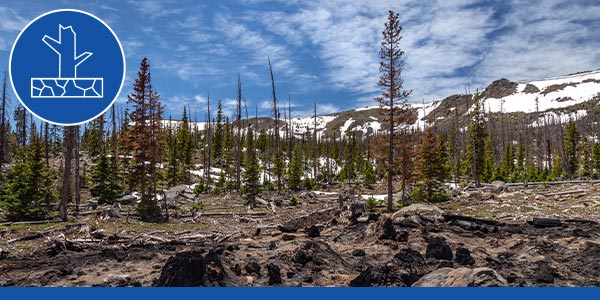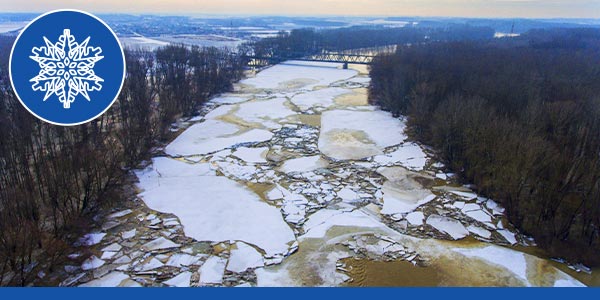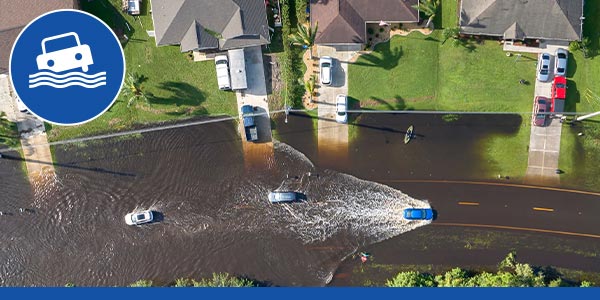What Causes Flooding?
In general, flooding occurs when water accumulates on the Earth’s surface faster than it can be absorbed, causing it to overflow onto land that is not normally underwater.
Prolonged or Intense Rainfall
Rainfall can cause flooding in various ways, such as persistent rain for an extended period (e.g., several days) and short—but incredibly intense—bursts of rain.
Tropical cyclones are notorious for dumping massive amounts of rain, but another hazard associated with these weather events causes devastating flooding—storm surge. See the section Coastal Flooding and Storm Surge for more information on tropical cyclones—including how they’re classified—and storm surge.
Wildfires
Severe flooding can also occur on land destroyed by fire. Wildfires can leave the land void of vegetation and the soil hydrophobic; it can take up to five years after a wildfire for vegetation to return.2
When rain falls, water runs across the Earth’s surface—rather than being absorbed—and picks up debris from the fire, resulting in dangerous mud and debris flows that can destroy homes and infrastructure. For example, a Presidential Disaster Declaration was made in 2011 after heavy rains fell on over 150,000 freshly burned acres in New Mexico.2
Learn more about the impact of wildfires in our Watersheds & Wildfires infographic from Mission: Water issue #7!

Wildfires cause the soil to become hydrophobic. When rain falls on the charred landscape, flood conditions can result because water cannot be absorbed into the ground.
Snowmelt
Snowmelt flooding naturally occurs in the spring when the winter snowpack melts in mountainous regions. It is ideal for the snowpack to gradually melt, but unusually warm air temperatures in the spring and rainfall on the snowpack—termed a rain-on-snow melt event—can result in dangerous flood conditions.3
Climate change has driven more frequent rain-on-snow melt events in different parts of the world, including Alaska and the Balkan regions of Europe.4 In December 2020, a significant rain-on-snow event resulted in flooding and landslides that impacted 1/3 of all residents in Haines, Alaska.5
Learn more about Earth's natural water towers in our snowpack infographic from Mission: Water issue #9!
Ice and Debris Jams
The spring thaw can cause other issues beyond snowmelt. Ice moving downstream can become lodged behind an obstruction—such as a bridge—resulting in water buildup behind the chunk of ice. Once it gives way, a sudden surge of water can be released, resulting in flooding downstream. This phenomenon can occur any time of the year with forest debris or even logs caught in rivers or streams.3

A sudden surge of water can be released downstream when an ice or debris jam finally breaks free.
Dam or Levee Failure
Similar to the release of water from an ice or debris jam, the sudden failure of a dam or levee can result in a massive pulse of water being released downstream, resulting in devastating flooding. This type of flooding is perhaps the worst, given how sudden and destructive it can be.
The cause of the failure can be natural (e.g., earthquake) or due to human error (e.g., design flaw).3 In September 2023, two dams in Libya failed due to heavy rains from Cyclone Daniel. As a result, thousands of people died—estimates range from 4,000 to over 11,000—and several officials were jailed due to allegations of mismanagement, negligence, and other mistakes that led to the dam failures.6
The loss can also result from an intentional act, such as the destruction of the Kakhovka Dam in southern Ukraine in June 2023. After the dam walls—over 60 feet (18 meters) tall and more than 100 feet (30 meters) thick—were destroyed by an explosion, a wall of water rushed downstream, causing widespread damage.7
Land Use Changes
Urbanization and deforestation significantly impact the likelihood and intensity of flooding events. Natural landscapes like forests and wetlands act as sponges, soaking up excess rainwater. However, replacing these landscapes with impermeable surfaces like asphalt and concrete increases runoff, contributing to more frequent and severe flooding.
One recent US-focused study concluded that a 1% increase in the amount of land paved over in a city—for new roads, sidewalks, or parking lots—can result in a 3.3% increase in the annual flood magnitude of nearby waterways.8
Flooding and Climate Change
According to many in the scientific community, a warming climate will continue to intensify adverse effects such as flooding.
The most recent comprehensive report released by the Intergovernmental Panel on Climate Change (IPCC)—the Sixth Assessment Report—explicitly states an increased risk for coastal and other low-lying cities and regions. An intensification of tropical cyclones9 is also expected due to increased ocean surface temperatures that fuel more energetic storms.10

More intense storms—fueled by climate change—have resulted in more devastating flooding in coastal areas and in locations far inland.
Outside of coastal areas, an increase in the frequency and intensity of heavy rainfall due to our changing climate is also likely to occur, resulting in devastating local flooding.9 Extreme rainfall events now mean a 1-in-100-year storm is likely to occur much more frequently than every 100 years in some areas.
A recent analysis showed that in 20 of the most populous counties in the United States, a 1-in-100-year precipitation event is now expected to occur about once per decade.11
It should be noted the relationship between climate change and flooding is complicated. Climate change has intensified storms, but the number of flood events has not necessarily increased.12